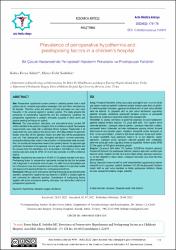| dc.contributor.author | Şahin, Kübra Evren | |
| dc.contributor.author | Sözbilen, Murat Celal | |
| dc.date.accessioned | 2022-10-03T10:13:57Z | |
| dc.date.available | 2022-10-03T10:13:57Z | |
| dc.date.issued | 2022 | en_US |
| dc.identifier.uri | https://dergipark.org.tr/tr/download/article-file/2452164 | |
| dc.identifier.uri | https://hdl.handle.net/20.500.12868/1769 | |
| dc.description.abstract | STRACT
Aim: Perioperative hypothermia is more common in pediatric patients than in adult
patients due to increased body surface area/weight ratio and limited subcutaneous
fat deposits. Therefore, active and passive warming techniques are used more
frequently in the surgeries applied to pediatric patients. This study presents the
prevalence of perioperative hypothermia and the predisposing conditions for
perioperative hypothermia in pediatric orthopedic surgeries in which active and
passive warming techniques are applied.
Methods: This cross-sectional, descriptive, and observational study included 102
children admitted to the pediatric orthopedic clinic of a children’s hospital. Temperature
measurements were made with a calibrated infrared tympanic thermometer in all
cases while they were waiting in the service room, when they entered the operation
theater, when they left the operation theater and when they left the postoperative
care unit. Their demographic data, hemogram and thyroid hormone parameters,
preoperative fasting times related to the procedure and temperature were recorded.
Also, the humidity and temperature values of the operating theater, the operation type
performed, the duration of the operation, the time spent in the operating theater and
the recovery time from anesthesia, were all recorded in their follow-up forms. Data
analysis was done using the SPSS V21.0 and was conducted at a 95% confidence
interval.
Results: Hypothermia was observed in 20.58% of 102 patients included in the study.
Predisposing factors for perioperative hypothermia included the fact that the patient
had a diagnosis of concomitant cerebral palsy, the patient's body temperature was
low in the service area, low temperature and humidity values in the operating theatre
and staying in the operating theatre for a prolonged period of time.
Conclusion: Although active and passive warming techniques are applied during the
operation, perioperative hypothermia was observed in 20.58% of pediatric patients
who underwent the orthopedic operation. Consideration of predisposing factors
together with active and passive warming techniques may reduce the incidence of
perioperative hypothermia. | en_US |
| dc.language.iso | eng | en_US |
| dc.relation.isversionof | 10.30565/medalanya.1122479 | en_US |
| dc.rights | info:eu-repo/semantics/openAccess | en_US |
| dc.subject | Hypothermia | en_US |
| dc.subject | Orthopedic surgery | en_US |
| dc.subject | Risk factors | en_US |
| dc.title | Prevalence of perioperative hypothermia and predisposing factors in a children's hospital | en_US |
| dc.title.alternative | Bir Çocuk Hastanesinde Perioperatif Hipotermi Prevalansı ve Predispozan Faktörler | en_US |
| dc.type | article | en_US |
| dc.contributor.department | ALKÜ | en_US |
| dc.identifier.volume | 6 | en_US |
| dc.identifier.issue | 2 | en_US |
| dc.identifier.startpage | 173 | en_US |
| dc.identifier.endpage | 178 | en_US |
| dc.relation.journal | Acta Medica Alanya | en_US |
| dc.relation.publicationcategory | Makale - Ulusal Hakemli Dergi - Başka Kurum Yazarı | en_US |


















